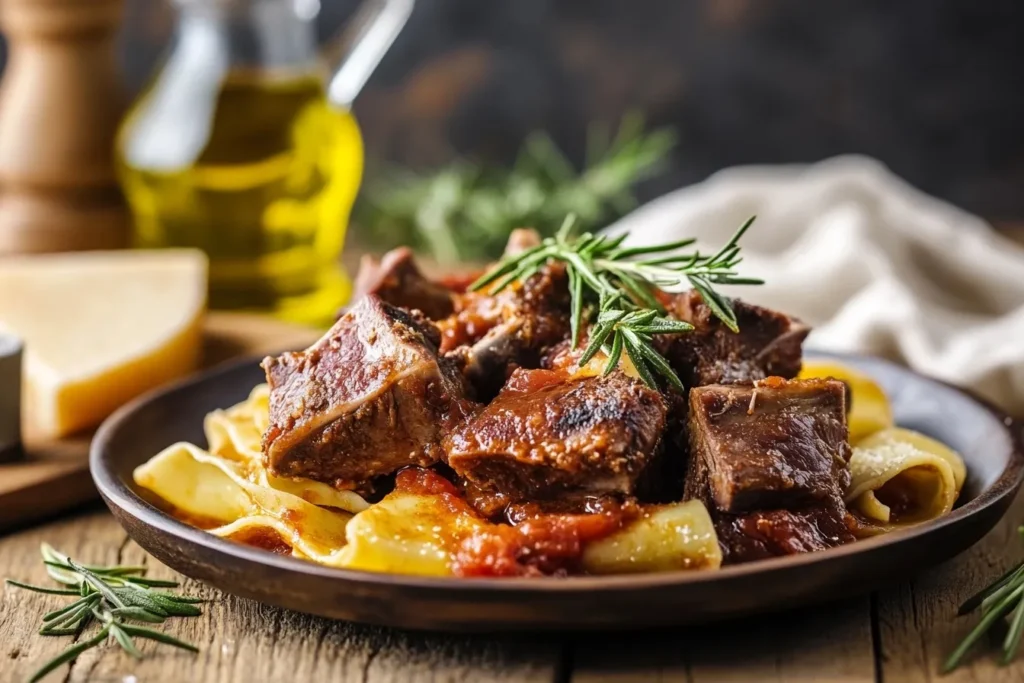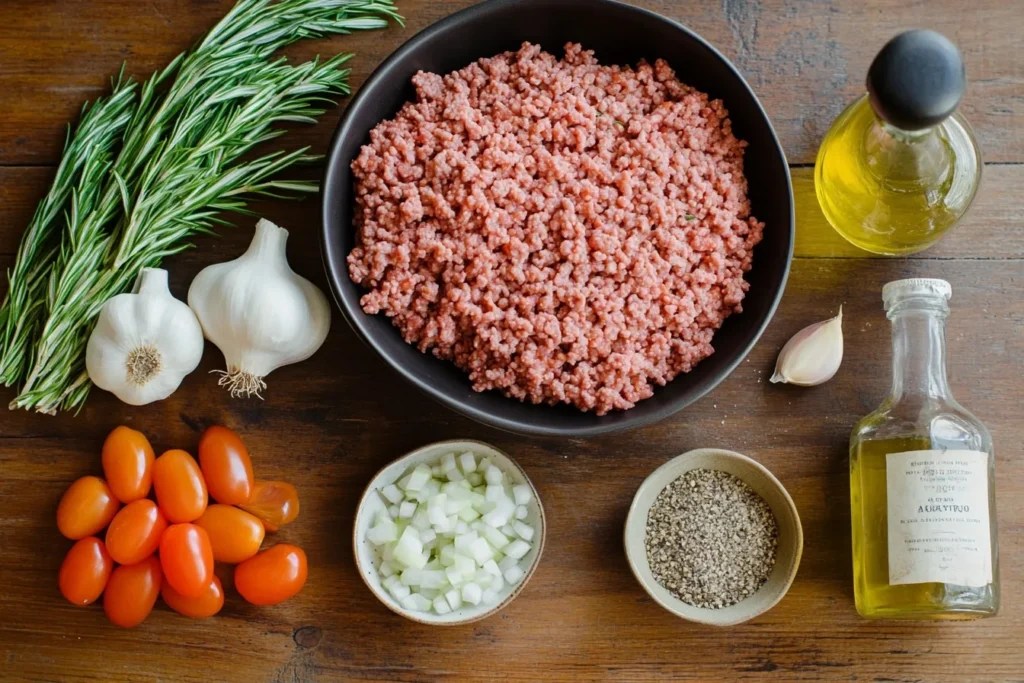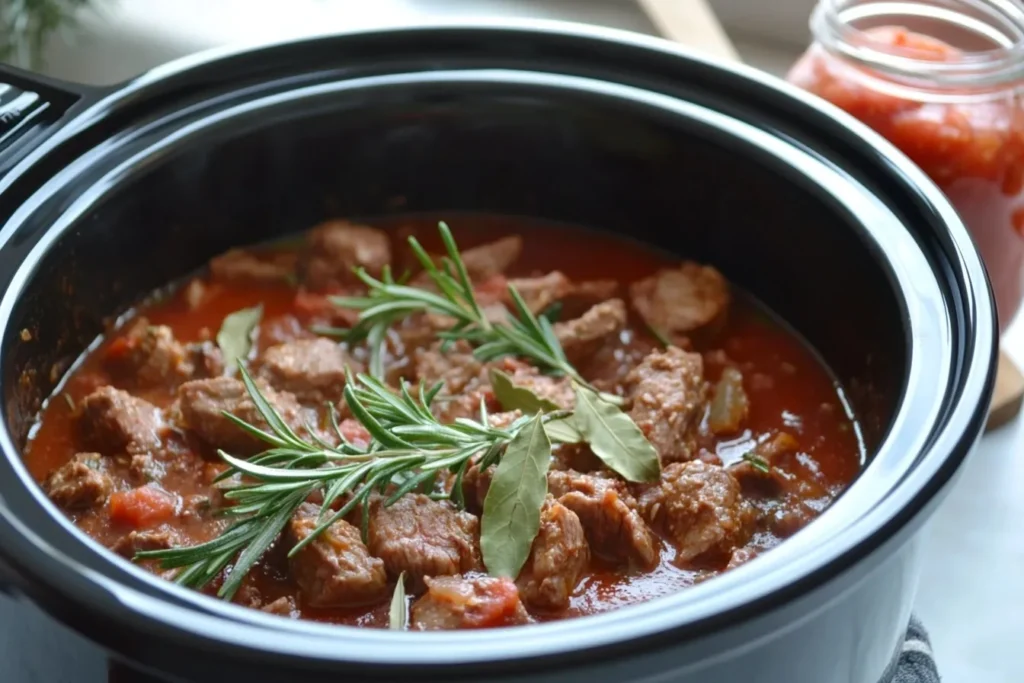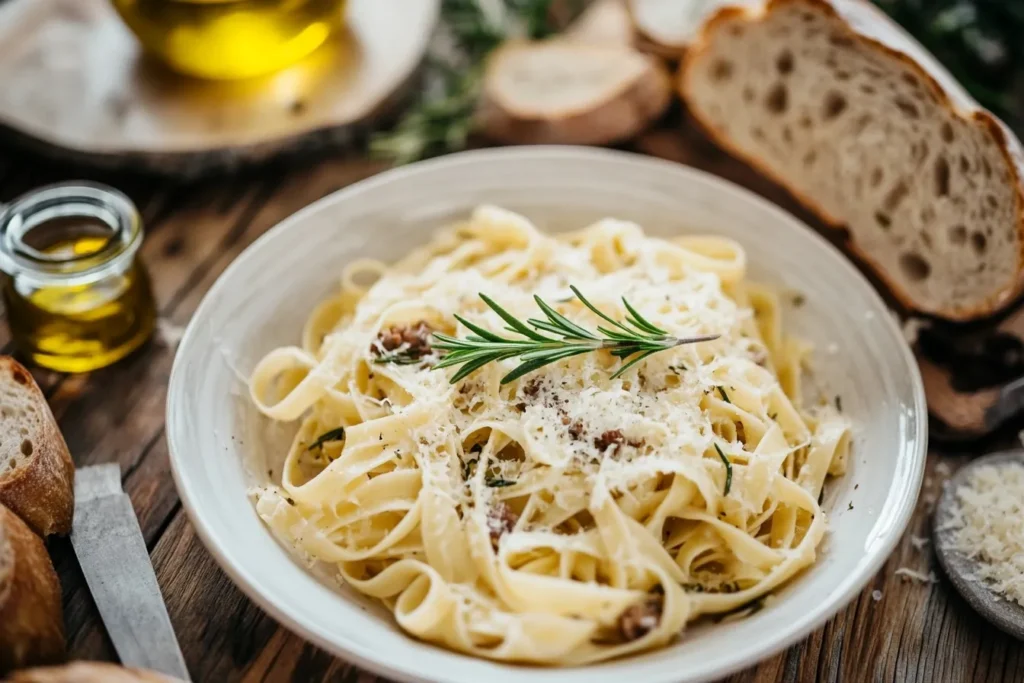Introduction to Lamb Ragu d’Abruzzo
What is Lamb Ragu d’Abruzzo?

Lamb Ragu d’Abruzzo is a classic Italian dish originating from the Abruzzo region, known for its rustic and earthy flavors. Unlike beef-based ragus, this recipe highlights the tender sweetness of ground lamb, creating a sauce that’s rich yet lighter than you might expect. The soffrito base—onions, celery, and carrots—blends beautifully with tomatoes and herbs to deliver an unforgettable depth of flavor.
Table of Contents
The Role of Rosemary in Italian Cuisine
Rosemary plays a starring role in this dish, lending its aromatic, piney notes to balance the richness of the lamb. As one of the most iconic herbs in Italian cooking, rosemary enhances the Mediterranean feel of this recipe. Paired with thyme and bay leaves, it creates a fragrant foundation that elevates the entire dish.
Why Lamb is the Star of This Dish
Lamb’s unique flavor makes it the perfect choice for this ragu. It brings an earthy sweetness that pairs wonderfully with the crushed tomatoes and savory herbs. While beef and pork are common in other ragus, lamb sets this version apart, making it a standout recipe for pasta lovers.
This dish isn’t just delicious; it’s a testament to the beauty of slow cooking, where every ingredient has time to meld and shine. Next, we’ll explore the key ingredients that bring this dish to life.
Key Ingredients for Lamb Ragu d’Abruzzo

Primary Ingredients: Ground Lamb and Tomatoes
The star of the lamb ragu d’abruzzo rosemary recipe is undoubtedly the ground lamb. Its rich, slightly sweet flavor pairs perfectly with the acidity of tomatoes. For the best results, opt for fresh or high-quality crushed tomatoes. These ingredients form the base of a robust sauce that will coat your pasta beautifully.
The Soffrito Base: Onions, Celery, and Carrots
No Italian ragu is complete without a soffrito. This simple yet essential trio—onions, celery, and carrots—provides the foundation for a flavorful sauce. When sautéed, they release natural sweetness, balancing the richness of the lamb and the tanginess of the tomatoes.
Herbs and Spices: Rosemary, Thyme, and Bay Leaves
Herbs like rosemary and thyme infuse this dish with a Mediterranean aroma that sets it apart from other ragus. Don’t forget the bay leaves, which add subtle depth. Tie the herbs into a bundle for easy removal once the sauce is cooked.
Optional Add-ins: Chili and Red Pepper Flakes
For those who enjoy a touch of heat, chili or red pepper flakes can be added. These spices enhance the overall profile without overpowering the delicate flavor of the lamb.
Tip: Learn more about the importance of using fresh herbs in recipes by visiting the Authentic Italian Escarole and Beans Recipe.
Step-by-Step Cooking Instructions

Preparing the Soffrito: Building the Flavor Base
Start by finely dicing onions, celery, and carrots. Heat olive oil in a pan, and sauté these veggies over medium heat. Stir frequently until they become soft and translucent. This step creates the aromatic backbone for your lamb ragu d’abruzzo rosemary recipe.
Browning the Lamb for Depth
Add the ground lamb to the pan, breaking it up with a wooden spoon. Cook until the meat is browned and slightly crispy. This step not only adds a rich texture but also deepens the flavor of your sauce.
Simmering for Perfection: Using the Slow Cooker or Stove
Once the lamb is browned, stir in crushed tomatoes and chicken broth. Add the rosemary, thyme, and bay leaves. Cover the pot and simmer on low heat for about 45 minutes, stirring occasionally. If using a slow cooker, let the sauce cook on the low setting for 8–12 hours.
Adjusting the Consistency of the Sauce
If the sauce seems too watery, let it simmer uncovered for 15-20 minutes to thicken. Alternatively, you can add a bouillon cube to intensify the flavor. The final result should be a luscious, hearty sauce that clings to pasta.
Pro Tip: For another slow-cooked masterpiece, check out Creamy Parmesan Italian Sausage Soup.
Pairing Lamb Ragu d’Abruzzo with the Perfect Sides

Traditional Pasta Pairings: Pappardelle and Tagliatelle
The lamb ragu d’abruzzo rosemary recipe truly shines when paired with wide, ribbon-like pasta such as pappardelle or tagliatelle. Their broad surfaces soak up the rich, flavorful sauce, ensuring every bite is a perfect balance of pasta and ragu. Fresh pasta, if available, elevates the dish even further, adding a tender, melt-in-your-mouth texture.
Alternative Options: Polenta and Gnocchi
For a twist, serve the ragu over creamy polenta or pillowy gnocchi. These alternatives offer a hearty base that complements the sauce’s richness. Polenta provides a rustic feel, while gnocchi adds a soft, doughy contrast to the robust lamb flavors.
Cheese and Garnishes for Finishing Touches
No Italian dish is complete without cheese. Sprinkle freshly grated Pecorino Romano or Parmesan over your plated ragu for a nutty, salty kick. Add a touch of red pepper flakes for a subtle heat or a drizzle of extra virgin olive oil for a silky finish. Garnishing with fresh rosemary sprigs also enhances the dish’s presentation.
Explore More: Looking for more hearty Italian ideas? Try the spaghetti and meatballs in a Dutch oven recipe for another comforting classic.
Tips for Enhancing the Recipe
Using Fresh vs. Dried Herbs
Fresh herbs like rosemary and thyme add vibrant flavors to the lamb ragu d’abruzzo rosemary recipe. However, dried herbs work well if fresh ones aren’t available. Remember to use about half the quantity of dried herbs as they are more concentrated.
Wine Choices: White or Red?
While red wine is a popular choice in many ragus, a splash of white wine enhances the lamb’s natural sweetness without overpowering the delicate balance of flavors. Choose a dry white wine like Sauvignon Blanc or Pinot Grigio for the best results.
Making It Ahead for Better Flavor
This dish tastes even better the next day. The extra time allows the flavors to meld beautifully. Store the sauce in an airtight container in the fridge for up to five days, or freeze it for up to three months. Reheat gently on the stove, adding a splash of water or broth if the sauce thickens too much.
Chef’s Suggestion: Want to try another flavor-packed Italian recipe? Check out the Authentic Italian Escarole and Beans Recipe for a quick and healthy option.
Storage and Reheating Tips
Refrigerating and Freezing the Sauce
One of the best things about the lamb ragu d’abruzzo rosemary recipe is how well it stores. If you have leftovers, transfer the sauce to an airtight container and refrigerate it for up to five days. The flavors often deepen as the dish rests, making it even tastier the next day. For longer storage, freeze the sauce in portion-sized containers for up to three months. Label each container with the date to keep track of freshness.
How to Reheat for Best Results
When reheating, it’s important to do so gently to preserve the rich flavors. If frozen, allow the ragu to thaw overnight in the fridge. Warm the sauce on the stove over low heat, stirring occasionally to prevent sticking. If the sauce feels too thick, add a splash of water, chicken broth, or even a touch of olive oil to restore its original consistency. Microwaving is an option, but be sure to stir every minute to heat evenly.
Extra Tip: Pair reheated ragu with fresh pasta for a just-made feel, or try it as a topping for baked potatoes or crusty bread for an unconventional twist.
Frequently Asked Questions (FAQs)
Can I Use a Different Meat Instead of Lamb?
Yes, you can! While the lamb ragu d’abruzzo rosemary recipe is traditionally made with lamb, substitutions like beef, pork, or even venison work well. Each meat brings its own unique flavor profile to the dish, so feel free to experiment.
What Pasta Works Best with Lamb Ragu?
Wide, ribbon-like pasta such as pappardelle or tagliatelle is ideal because it holds the sauce beautifully. However, alternatives like rigatoni or polenta also complement the hearty ragu.
Can I Make This Recipe Gluten-Free?
Absolutely. Substitute regular pasta with gluten-free options, such as chickpea or brown rice pasta. Polenta is naturally gluten-free and pairs wonderfully with the rich sauce.
How Can I Thicken the Sauce if It’s Too Watery?
If your sauce is too thin, let it simmer uncovered for 15-20 minutes to reduce excess liquid. Another trick is to stir in a small amount of tomato paste or a slurry made from cornstarch and water.
More Cooking Inspiration: For other gluten-free ideas, check out Rice Pasta: A Gluten-Free Alternative for Every Meal.
Conclusion and Final Thoughts
Why This Dish Represents the Best of Italian Comfort Food
The lamb ragu d’Abruzzo rosemary recipe highlights the essence of Italian cuisine. Moreover, this dish demonstrates how simple, high-quality ingredients can become something extraordinary. Specifically, the tender lamb absorbs the flavors of rosemary and thyme while blending seamlessly with a rich tomato base. As a result, the sauce feels both rustic and refined. Furthermore, when paired with pasta, polenta, or crusty bread, it delivers an authentic taste of Abruzzo’s culinary heritage.
Encouragement to Experiment and Share Your Creation
Cooking is about creativity and sharing joy with others. While this recipe is rooted in tradition, don’t hesitate to put your own spin on it. Add a splash of wine, try different herbs, or experiment with gluten-free pasta options. Once you’ve perfected your version of the lamb ragu d’abruzzo rosemary recipe, serve it to friends and family. A hearty meal like this is best enjoyed with loved ones around the table.
Tip for More Inspiration: For another take on hearty Italian dishes, explore Spaghettini Pasta: Quick and Delicious Italian Dining.

